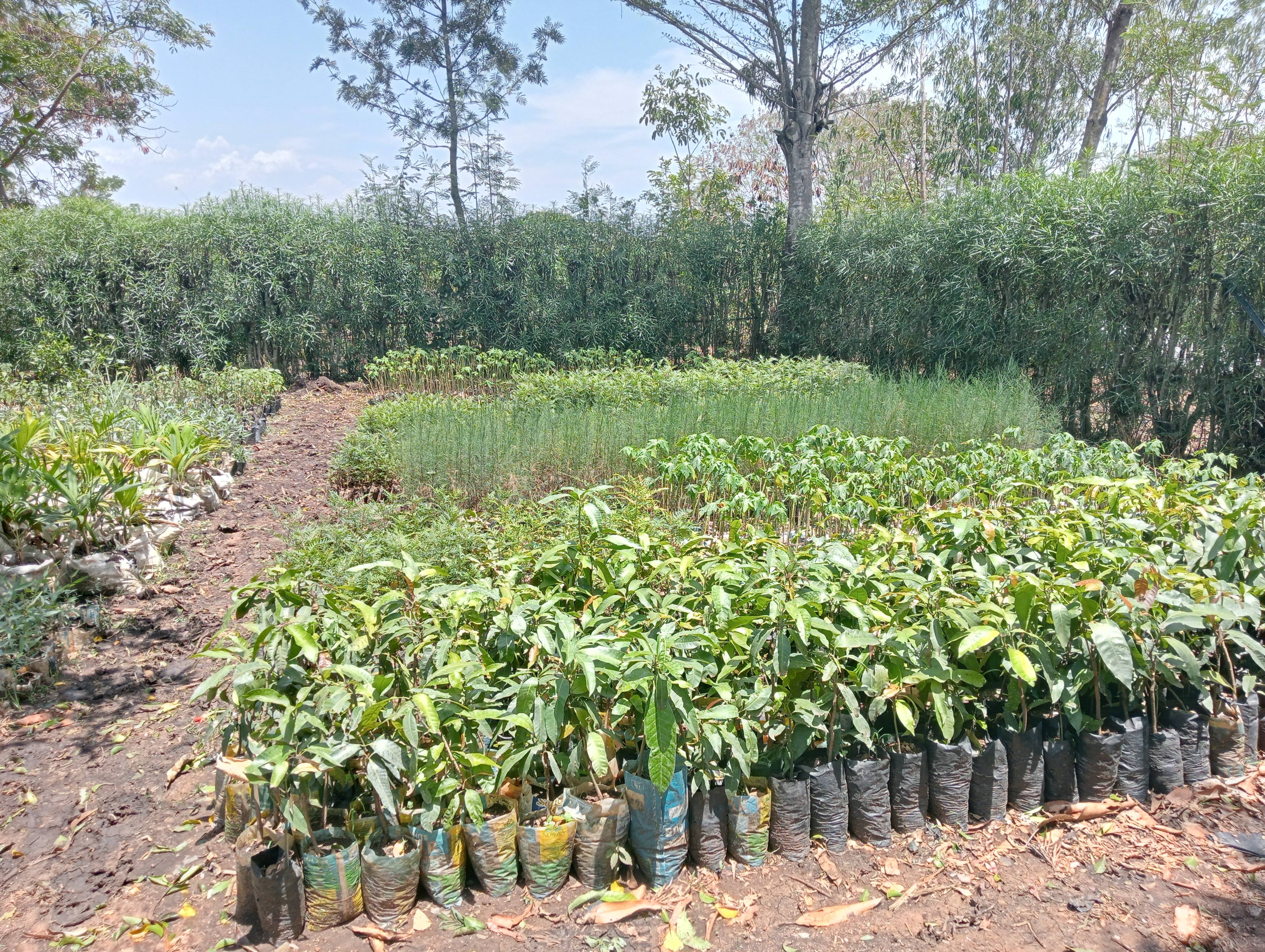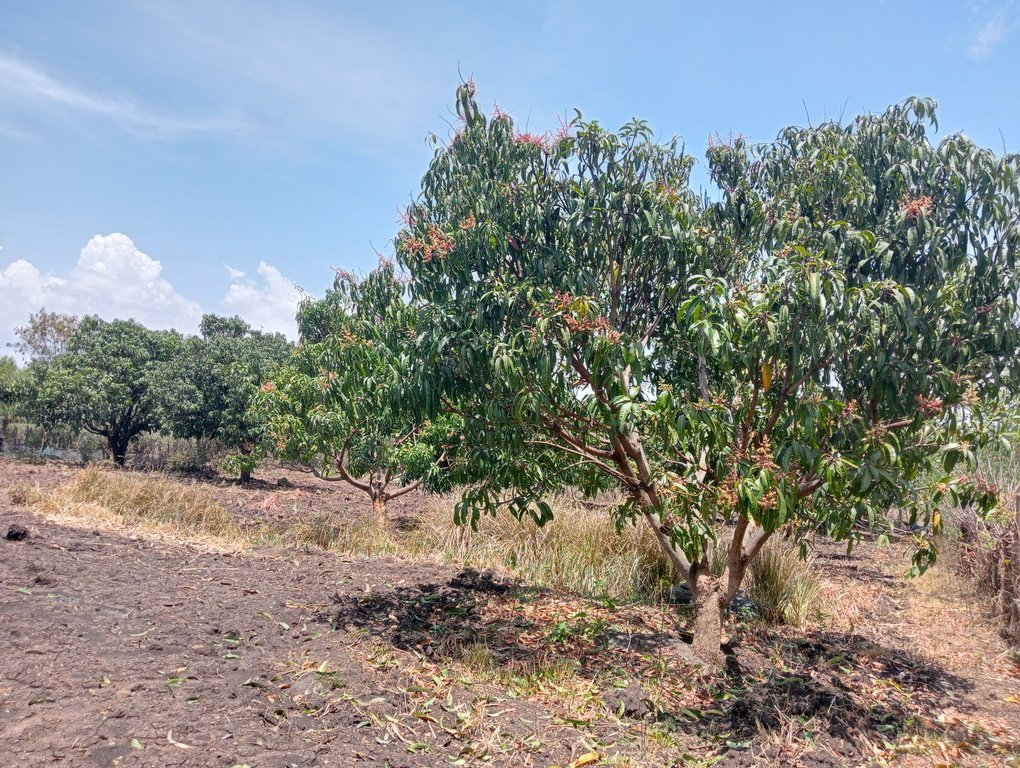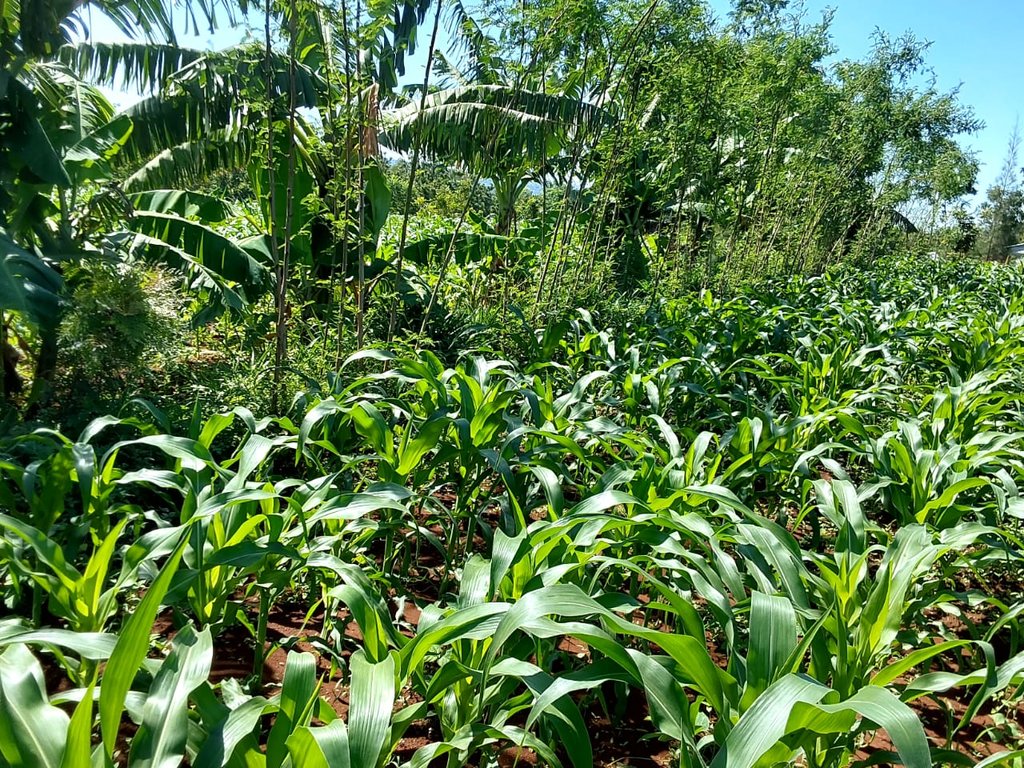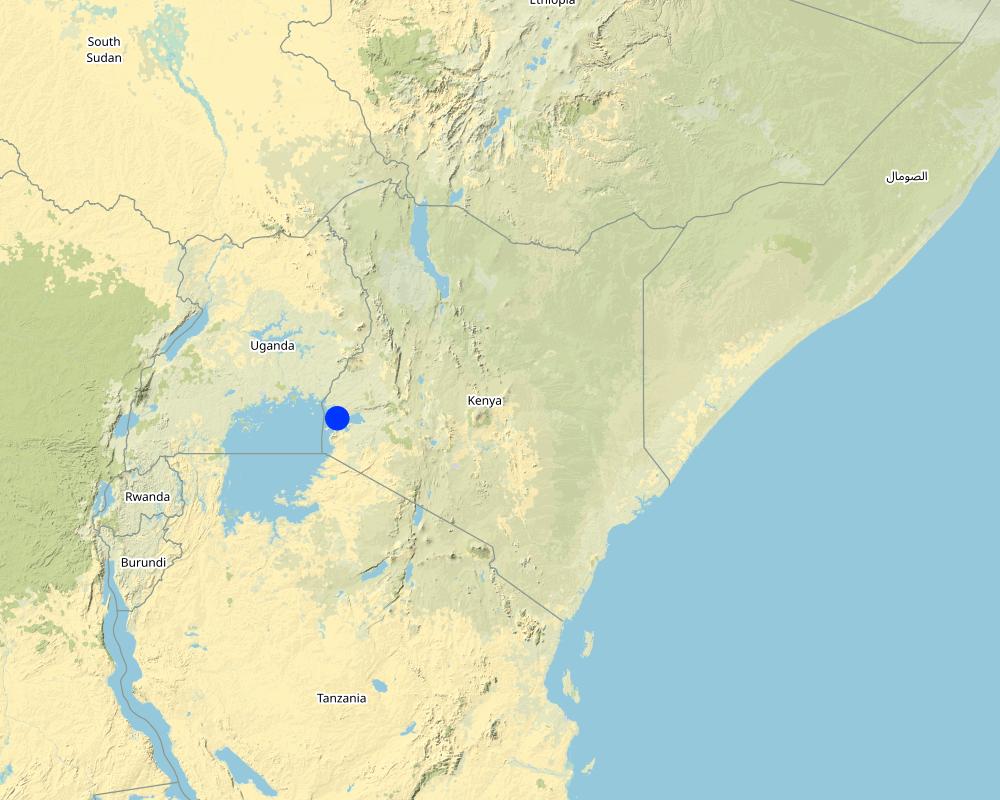Promotion of different trees for agroforestry [ເຄັນຢາ]
- ການສ້າງ:
- ປັບປູງ:
- ຜູ້ສັງລວມຂໍ້ມູນ: William Akwanyi
- ບັນນາທິການ: JARED AYIENA, Innocent Faith, Noel Templer, JUSTINE OTSYULA
- ຜູ້ທົບທວນຄືນ: William Critchley, Rima Mekdaschi Studer
approaches_6706 - ເຄັນຢາ
ເບິ່ງພາກສ່ວນ
ຂະຫຍາຍທັງໝົດ ຍຸບທັງໝົດ1. ຂໍ້ມູນທົ່ວໄປ
1.2 ລາຍລະອຽດ ການຕິດຕໍ່ ຂອງບຸກຄົນທີ່ຊັບພະຍາກອນ ແລະ ສະຖາບັນ ການມີສ່ວນຮ່ວມ ໃນການປະເມີນຜົນ ແລະ ເອກະສານ ຂອງວິທີທາງ
ບຸກຄົນສຳຄັນ (ຫຼາຍຄົນ)
ຜູ້ນໍາໃຊ້ທີ່ດິນ:
Omolo Charles Abok
+254 728 135152
charlesabok88@gmail.com
Welthungerhilfe farmer
Nyaguda Village, South Sakwa Ward, Bondo Sub-county in Siaya County
ເຄັນຢາ
ຜູ້ຊ່ຽວຊານ ດ້ານການຄຸ້ມຄອງ ທີ່ດິນແບບຍືນຍົງ:
ຜູ້ຊ່ຽວຊານ ດ້ານການຄຸ້ມຄອງ ທີ່ດິນແບບຍືນຍົງ:
ຊື່ຂອງໂຄງການ ທີ່ອໍານວຍຄວາມສະດວກ ໃນການສ້າງເອກກະສານ ຫຼື ປະເມີນດ້ານແນວທາງ (ຖ້າກ່ຽວຂ້ອງ)
Soil protection and rehabilitation for food security (ProSo(i)l)ຊື່ຂອງ ສະຖາບັນການຈັດຕັ້ງ ທີ່ອໍານວຍຄວາມສະດວກ ໃນການສ້າງເອກກະສານ ຫຼື ປະເມີນແນວທາງ (ຖ້າກ່ຽວຂ້ອງ)
Deutsche Gesellschaft für Internationale Zusammenarbeit (GIZ)ຊື່ຂອງ ສະຖາບັນການຈັດຕັ້ງ ທີ່ອໍານວຍຄວາມສະດວກ ໃນການສ້າງເອກກະສານ ຫຼື ປະເມີນແນວທາງ (ຖ້າກ່ຽວຂ້ອງ)
Alliance Bioversity and International Center for Tropical Agriculture (Alliance Bioversity-CIAT) - ເຄັນຢາ1.3 ເງື່ອນໄຂ ຂອງການນໍາໃຊ້ເອກກະສານຂໍ້ມູນ ຂອງ WOCAT
ເມື່ອໃດທີ່ໄດ້ສັງລວມຂໍ້ມູນ (ຢູ່ພາກສະໜາມ)?
01/03/2023
ຜູ້ສັງລວມ ແລະ ບັນດາຜູ້ຕອບແບບສອບຖາມ ຍອມຮັບໃນເງື່ອນໄຂ ການນໍາໃຊ້ຂໍ້ມູນເອກະສານ ທີ່ສ້າງຂື້ນ ໂດຍຜ່ານ ອົງການ WOCAT:
ແມ່ນ
1.4 ເອກະສານອ້າງອີງ (ຫຼາຍ) ກັບແບບສອບຖາມ (ຫຼາຍ) ເຕັກໂນໂລຢີ ຂອງດ້ານການຄຸ້ມຄອງ ດິນແບບຍືນຍົງ
2. ພັນລະນາ ແນວທາງການຄຸ້ມຄອງນໍາໃຊ້ດິນແບບຍືນຍົງ
2.1 ການອະທິບາຍ ໂດຍຫຍໍ້ ຂອງວິທີທາງ
Promoting the values of different trees and their benefits in agroforestry contributes to increased adoption by farmers.
2.2 ການອະທິບາຍ ລາຍລະອຽດ ຂອງວິທີທາງ
ການອະທິບາຍ ລາຍລະອຽດ ຂອງວິທີທາງ:
Agroforestry involves the integration of trees and/ or shrubs in a farming system on the same land where crops or pastures are grown. It offers significant environmental, economic, and social benefits. Agroforestry also enables farmers to diversify their on-farm income. Furthermore, it contributes to climate change adaptation and mitigation and improves the environment within the farm, especially soils. However, not every farmer is willing to adopt agroforestry. Trees and shrubs take up space that would have been dedicated to crops or pasture: this is a primary reason why farmers are not willing to plant trees and/ or shrubs on their farms. Similarly, many farmers do not clearly understand the values of some trees and shrubs. It is, therefore, essential to overcome the barriers to adopting agroforestry among farmers.
The ProSoil project has created awareness among farmers in Kakamega, Bungoma, and Siaya Counties about the more efficient and profitable tree and shrub-based value chains to attract farmers to agroforestry and pave the way for greater uptake. The farmers were targeted through their groups. Each group consisting of about 25 farmers, and with at least 30% women. Farmers are introduced to trees and/ or shrubs that blend well with their farming system. In addition, farmers choose trees and/ or shrubs based on the sizes of their farming land and their respective benefits. Farmers can plant trees and shrubs as single stands or integrate them into farming land. They can also plant agroforestry trees around their homesteads. A single stand can have, for example, mangos, avocados, and/or other trees. The project advocates for a more sustainable win-win approach where farmers and the environment benefit from an agroforestry system. Some of the benefits of trees and shrubs, as highlighted by the project, include the following:
a) Soil erosion control: trees and shrubs are planted on across slopes to slow down runoff and trap sediment (consequently, accumulating soil – this can form terraces after several years). Their roots hold the soil in place and reduce the impact of moving water.
b) Stabilising stream banks and gullies (e.g., Leucaena leucocephala, Sesbania grandiflora, Moringa oleifera, etc.): help to reduce soil erosion along streams and gullies when planted at the medium- to high-level watermark. Their roots hold the soil in place and reduce the impact of moving water.
c) Green manure (e.g., Sesbania sesban, Tithonia sp., etc.): from foliage and twigs.
d) Live fences (e.g., Tithonia sp.): used as boundaries to provide privacy and protection from browsing animals.
e) Windbreakers (e.g., Casuarina equisetifolia, Grevillea robusta, Leucaena leucocephala, etc.): planted in one or two rows/ lines closely together along the edges of the farm and perpendicular to winds to protect crops, soils, and structures from the detrimental effects of wind.
f) Fodder (e.g., Grevillea robusta, Sesbania sesban, Leucaena leucocephala, etc.): foliage is food for livestock.
g) Food (e.g., mangoes, avocadoes, etc.): a human food source.
h) Carbon sequestration (all trees and shrubs): they act as carbon sinks by capturing carbon dioxide from the atmosphere.
2.3 ຮູບພາບຂອງແນວທາງ
2.5 ປະເທດ / ເຂດ / ສະຖານທີ່ບ່ອນທີ່ແນວທາງໄດ້ຖືກນໍາໃຊ້
ປະເທດ:
ເຄັນຢາ
ພາກພື້ນ / ລັດ / ແຂວງ:
Siaya County, Nyanza Region
ຂໍ້ມູນເພີ່ມເຕີມຂອງສະຖານທີ່:
Nyagudha village, South Sakwa Ward, Bondo Sub-county
Map
×2.6 ວັນທີເລີ່ມຕົ້ນ ແລະ ສິ້ນສຸດ ການຈັດຕັ້ງປະຕີບັດ ວິທີທາງ
ສະແດງປີຂອງການເລີ່ມຕົ້ນ:
2019
2.7 ປະເພດຂອງແນວທາງ
- Both traditional practice and project based: farmers have been growing trees and shrubs on their farms but the ProSoil project introduced them to more beneficial trees and better ways of producing the trees e.g., through grafting.
2.8 ເປົ້າໝາຍ / ຈຸດປະສົງຫຼັກ ຂອງການຈັດຕັ້ງປະຕິບັດ ວິທີທາງ
Aim: To promote the adoption of agroforestry.
Objectives:
1) To introduce farmers to the diverse benefits of trees in farming.
2) To encourage farmers to incorporate trees and/ or shrubs in their farming.
2.9 ເງື່ອນໄຂອໍານວຍ ຫຼື ຂັດຂວາງການປະຕິບັດຂອງເຕັກໂນໂລຢີ / ເຕັກໂນໂລຢີການນໍາໃຊ້ຕາມແນວທາງ
ສັງຄົມ / ວັດທະນະທໍາ / ມາດຕະຖານ ແລະ ຄຸນຄ່າທາງສາສະໜາ
- ອໍານວຍ
Trees play a central role in the socio-cultural lives of people and are used for a wide range of cultural practices.
- ເຊື່ອງຊ້ອນ
Cultural beliefs: e.g., women are not supposed to plant (some) trees as this is considered a male role. This hinders women from full participation in agroforestry activities.
ມີຄວາມສາມາດ / ເຂັ້າເຖິງຊັບພະຍາກອນດ້ານການເງິນ ແລະ ການບໍລິການ
- ເຊື່ອງຊ້ອນ
Some farmers do not have adequate financial resources to purchase seedling of some tree and shrub seedlings.
ການຮ່ວມມື / ການປະສານງານຂອງຜູ້ກ່ຽວຂ້ອງ
- ອໍານວຍ
Other institutions such as the county governments pass agroforestry information to farmers through the public agricultural extension officers. County governments are important collaborators in the ProSoil project.
ກ່ຽວກັບກົດໝາຍ (ສິດນໍາໃຊ້ດິນ, ສິດນໍາໃຊ້ນໍ້າ)
- ເຊື່ອງຊ້ອນ
Trees and/ or shrubs take several years to mature. This is closely linked to land tenure since most people would prefer to establish trees only on their farms.
ນະໂຍບາຍ
- ອໍານວຍ
Kenya's 10 Percent Tree Cover Strategy includes the component of promoting farm forestry through various platforms e.g., radio and TV.
ການປົກຄອງທີ່ດິນ (ການຕັດສິນໃຈ, ການປະຕິບັດ ແລະ ຂໍ້ບັງຄັບ)
- ເຊື່ອງຊ້ອນ
Women and youth have little or no control over land in most communities. Hence, they cannot make decisions to plant (some) trees on the family land.
ຄວາມຮູ້ກ່ຽວກັບການຄຸ້ມຄອງ ທີ່ດິນແບບຍືນຍົງ, ການເຂົ້າເຖິງການສະໜັບສະໜູນ ທາງດ້ານວິຊາການ
- ອໍານວຍ
ProSoil project has supported the dissemination of information about the importance of agroforestry as an SLM technology and how to propagate trees e.g., through grafting. As a result, some farmers have established trees nurseries.
ຕະຫຼາດ (ໃນການຊື້ວັດຖຸດິບ, ຂາຍຜະລິດຕະພັນ) ແລະ ລາຄາ
- ອໍານວຍ
The increasing awareness about the benefits of many trees has led to an increase in the demand for the different products from the trees e.g., fruits, honey, medicines, etc. This potential of trees to generate income encourages farmers to plant trees.
3. ການມີສ່ວນຮ່ວມ ແລະ ບົດບາດຂອງພາກສ່ວນທີ່ກ່ຽວຂ້ອງທີ່ໄດ້ມີສ່ວນຮ່ວມ
3.1 ຜູ້ມີສ່ວນຮ່ວມ ໃນວິທີທາງ ແລະ ພາລະບົດບາດ ຂອງເຂົາເຈົ້າ
- ຜູ້ນໍາໃຊ້ດິນໃນທ້ອງຖິ່ນ / ຊຸມຊົນທ້ອງຖິ່ນ
Farmers, farmer groups (women, youth, and mixed gender)
Recipients of the trainings in agroforestry.
- ຜູ້ຊ່ຽວຊານ ການນຄຸ້ມຄອງ ທີ່ດິນແບບຍືນຍົງ / ທີ່ປຶກສາດ້ານກະສິກໍາ
GIZ ProSoil project SLM specialists; specialists from the implementing partner, Welthungerhilfe; and county SLM specialists from the departments of agriculture and environment.
Provides technical advice to the farmers and link farmers to markets and tree nurseries.
- ອໍານາດ ການປົກຄອງທ້ອງຖິ່ນ
County government agriculture and environment departments
Provides technical advice to the farmers and link farmers to markets and tree nurseries.
- ອົງການຈັດຕັ້ງ ສາກົນ
GIZ
Financial support to the technical team and farmers during capacity building.
ຖ້າຫາກມີຫຼາຍພາກສ່ວນທີ່ເຂົ້າຮ່ວມ ໃຫ້ລະບຸ ອົງການທີ່ເປັນຫຼັກ ໃນການຈັດຕັ້ງປະຕິບັດ:
GIZ
3.2 ການມີສ່ວນຮ່ວມຂອງຜູ້ນໍາໃຊ້ທີ່ດິນໃນທ້ອງຖິ່ນ / ຊຸມຊົນທ້ອງຖິ່ນໃນໄລຍະທີ່ແຕກຕ່າງກັນຂອງແນວທາງ
| ການລວບລວມ ເອົາຜູ້ນໍາໃຊ້ດິນ ໃນທ້ອງຖິ່ນ / ຊຸມຊົນທ້ອງຖິ່ນ | ໃຫ້ລະບຸ ຜູ້ໃດທີ່ມີສ່ວນຮ່ວມ ໃນແຕ່ລະກິດຈະກໍາ? | |
|---|---|---|
| ການເລີ່ມຕົ້ນ / ແຮງຈູງໃຈ | ການນໍາໃໍຊ້ເອງ | Farmers involved in the training in agroforestry. |
| ການວາງແຜນ | ການຮ່ວມມື | Farmers consulted on where and when to establish demos of agroforestry tree nurseries. |
| ການປະຕິບັດ | ການນໍາໃໍຊ້ເອງ | Although farmers are advised which trees are better for their farms, they are the final decision makers on which trees and shrubs to incorporate in their farms. |
| ຕິດຕາມກວດກາ / ການປະເມີນຜົນ | ການບໍ່ປະຕິບັດ | Interviews with implementing farmers. |
| ບໍ່ມີ |
3.3 ແຜນວາດ (ຖ້າມີ)
ການອະທິບາຍ:
The ProSoil project (GIZ and WHH) provides financial (transport reimbursement) and material (seedlings) support to farmers through their groups (Ndati Development Self-Help Group). The project also facilitates the county departments of Agriculture and Environment to train farmers in agroforestry and increase their awareness about the socio-economic and ecological benefits of different trees. at the farm.
ຜູ້ຂຽນ:
William Akwanyi
3.4 ການຕັດສິນໃຈກ່ຽວກັບການຄັດເລືອກເຕັກໂນໂລຢີຂອງການຄຸ້ມຄອງທີ່ດິນແບບຍືນຍົງ / ເຕັກໂນໂລຢີ
ລະບຸ ຄົນທີ່ຕັດສິນໃຈ ກ່ຽວກັບການຄັດເລືອກຂອງ ເຕັກໂນໂລຢີ / ເຕັກໂນໂລຢີ ຈະໄດ້ຮັບການປະຕິບັດ:
- ຜູ້ນໍາໃຊ້ທີ່ດິນຫຼັກ, ການສະໜັບສະໜູນ ໂດຍຜູ້ຊ່ຽວຊານ ການນໍາໃຊ້ທີ່ດິນແບບຍືນຍົງ
ອະທິບາຍ:
The ProSoil project team provides technical support on the selection of trees based on the diverse needs of farmers, and the sizes and locations of their farms. However, the final decision to plant which type(s) of trees and where to plant them at the farm rests with the farmer.
Specify on what basis decisions were made:
- ປະເມີນເອກກະສານ ຄວາມຮູ້ກ່ຽວກັບ ການຄຸ້ມຄອງ ທີ່ດິນແບບຍືນຍົງ (ຫຼັກຖານທີ່ຊ່ວຍໃນການຕັດສິນໃຈ)
- ປະສົບການສ່ວນບຸກຄົນ ແລະ ຄວາມຄິດເຫັນ (ທີ່ບໍ່ເປັນເອກກະສານ)
4. ການສະໜັບສະໜູນທາງດ້ານວິຊາການ, ການສ້າງຄວາມສາມາດ, ແລະ ການຈັດການຄວາມຮູ້.
4.1 ການສ້າງຄວາມສາມາດ / ການຝຶກອົບຮົມ
ຜູ້ນໍາໃຊ້ທີ່ດິນ ຫຼື ພາກສ່ວນກ່ຽວຂ້ອງອື່ນໆ ໄດ້ຮັບການຝຶກອົບຮົມບໍ່?
ແມ່ນ
ໃຫ້ລະບຸ ຜູ້ໃດທີ່ໄດ້ຮັບການຝຶກອົບຮົມ:
- ຜູ້ນໍາໃຊ້ດິນ
ຮູບແບບຂອງການຝຶກອົບຮົມ:
- ຕົວຕໍ່ຕົວ
- ເນື້ອທີ່ສວນທົດລອງ
ໃນຫົວຂໍ້:
1. Different trees in agroforestry and their benefits
2. Tree nursery management
3. Grafting
4. Agroforestry systems
5. Value addition to agroforestry products and marketing
ຄວາມຄິດເຫັນ:
Welthungerhilfe contracted SLM specialists from the county departments of agriculture and environment to train farmers and carry out demonstrations on tree planting and value addition in their groups during sessions organized by the ProSoil project. Other farmers are learning from the trained farmers. These specialists also advice farmers during farm visits.
4.2 ການບໍລິການໃຫ້ຄໍາປຶກສາ
ເຮັດຜູ້ໃຊ້ທີ່ດິນມີການເຂົ້າເຖິງການບໍລິການໃຫ້ຄໍາປຶກສາ?
ແມ່ນ
ລະບຸວ່າການສະໜອງ ການບໍລິການ ໃຫ້ຄໍາປຶກສາ:
- ໃນພື້ນທີ່ຂອງຜູ້ນໍາໃຊ້ດິນ
- ສູນຄົ້ນຄວ້າ
- Specific locations where the farmers interact with the technical officers and at their farms.
ອະທິບາຍ / ຄວາມຄິດເຫັນ:
Farmers were trained in their groups at specific venues during sessions organized by the ProSoil project/ WHH. Other farmers are learning from the trained farmers. These specialists also advice farmers during farm visits.
4.3 ສະຖາບັນການສ້າງຄວາມເຂັ້ມແຂງ (ການພັດທະນາອົງການຈັດຕັ້ງ)
ສະຖາບັນ ໄດ້ຮັບການສ້າງຕັ້ງຂື້ນ ຫຼື ໄດ້ຮັບການສ້າງຄວາມເຂັ້ມແຂງ ໂດຍການຈັດຕັ້ງປະຕິບັດ ວິທີທາງບໍ່?
- ມີ, ໜ້ອຍໜຶ່ງ
ລະບຸ ທາງສະຖາບັນ ໄດ້ສ້າງຄວາມເຂັ້ມແຂງ ໃນລະດັບໃດ (ຫຼາຍ):
- ທ້ອງຖິ່ນ
ອະທິບາຍ ສະຖາບັນການຈັດຕັ້ງ, ພາລະບົດບາດ ແລະ ໜ້າທີ່ຮັບຜິດຊອບ, ສະມາຊິກ ແລະ ອື່ນໆ.
Farmers have formed groups such as Ndati Development Self-Help Group e.g., to run tree nurseries. The groups consist of several men and women of diverse ages. Farmers develop funding and other support proposals through the groups.
ລະບຸ ປະເພດ ຂອງສະໜັບສະໜູນ:
- ການສ້າງຄວາມອາດສາມາດ / ການຝຶກອົບຮົມ
- ອຸປະກອນ
ໃຫ້ລາຍລະອຽດເພີ່ມເຕີມ:
Trainings in agroforestry, markets, tree propagation, etc.
Nursery materials and equipment including water tanks, seeds and grafting tools
4.4 ຕິດຕາມກວດກາ ແລະ ປະເມີນຜົນ
ການຈັດຕັ້ງປະຕິບັດ ວິທີທາງ ໄດ້ມີການປະເມີນຜົນ ແລະ ຕິດຕາມບໍ?
ແມ່ນ
ຄວາມຄິດເຫັນ:
GIZ and Welthungerhilfe regularly follows up with farmers to check on the implementation of technologies promoted under this approach.
ຖ້າແມ່ນ, ເອກກະສານສະບັບນີ້ ແມ່ນໄດ້ນໍາໃຊ້ເຂົ້າໃນການຕິດຕາມ ແລະ ປະເມີນຜົນບໍ່?
ບໍ່ແມ່ນ
ຄວາມຄິດເຫັນ:
This documentation in intended for keeping a record of SLM technologies and approaches.
4.5 ການຄົ້ນຄວ້າ
ນີ້້ແມ່ນສ່ວນໜຶ່ງ ການຄົ້ນຄວ້າ ຂອງວິທີທາງບໍ່?
ບໍ່ແມ່ນ
5. ການສະໜັບສະໜູນທາງດ້ານການເງິນ ແລະ ອຸປະກອນຈາກພາຍນອກ
5.1 ງົບປະມານປະຈໍາປີ ສໍາລັບວິທີທາງ ຂອງການຄຸ້ມຄອງ ທີ່ດິນແບບຍືນຍົງ
ຖ້າຫາກບໍ່ຮູ້ຈັດງົບປະມານທີ່ແນ່ນອນ ແມ່ນໃຫ້ປະມານເອົາ:
- 10,000-100,000
ຄໍາເຫັນ (ຕົວຢ່າງ: ແຫຼ່ງຂໍ້ມູນຫຼັກ ຂອງການສະໜອງທຶນ / ຜູ້ໃຫ້ທຶນທີ່ສໍາຄັນ):
ProSoil project facilitated trainings on the SLM technologies under this approach, including transport reimbursement to farmers and trainers and remuneration to trainers during trainings. Farmers meet the costs of land preparation, acquiring seeds and seedlings, planting trees, and managing the trees. The stated budget is for training one farmer group of about 25 farmers.
5.2 ການສະໜັບສະໜູນ ທາງດ້ານການເງິນ / ອຸປະກອນ ສະໜອງໃຫ້ແກ່ຜູ້ນໍາທີ່ດິນ
ຜູ້ນໍາໃຊ້ດິນ ໄດ້ຮັບການສະໜັບສະໜູນ ທາງດ້ານ ການເງິນ / ອຸປະກອນ ໃນການຈັດຕັ້ງປະຕິບັດ ເຕັກໂນໂລຢີບໍ?
ແມ່ນ
ຖ້າແມ່ນ, ໃຫ້ລະບຸປະເພດ (ຫຼາຍ) ຂອງການສະໜັບສະໜູນ, ເງື່ອນໄຂ ແລະ ຜູູ້ສະໜອງ (ຫຼາຍ):
The ProSoil project through Welthungerhilfe supported the farmers (through their group) with trainings and setting up demo plots.
5.3 ເງິນສົມທົບສໍາລັບການນໍາໃຊ້ສະເພາະປັດໃຈຂາເຂົ້າໃນການຜະລີດກະສິກໍາ (ລວມທັງແຮງງານ)
- ບໍ່ມີ
ຖ້າແຮງງານ ຂອງຜູ້ນໍາໃຊ້ດິນ ໄດ້ຮັບການສະໜັບສະໜູນ ປັດໃຈຂາເຂົ້າ, ແມ່ນບໍ່:
- ການອາສາ
ຄວາມຄິດເຫັນ:
Farmers voluntarily provided labour at the demonstration plot and on their own land.
5.4 ສິນເຊື່ອ
ໄດ້ປ່ອຍສິນເຊື່ອ ສະໜອງໃຫ້ພາຍໃຕ້ ວິທີການສໍາລັບກິດຈະກໍາ ການຄຸ້ມຄອງ ທີ່ດິນແບບຍືນນຍົງບໍ່?
ບໍ່ແມ່ນ
5.5 ສິ່ງຈູງໃຈ ຫຼື ເຄື່ອງມືອື່ນໆ
ການສົ່ງເສີມ ຈັດຕັ້ງປະຕິບັດ ເຕັກໂນໂລຢີ ໃນການຄຸ້ມຄອງ ດິນແບບຍືນຍົງ ໄດ້ສະໜອງສິ່ງກະຕຸກຊຸກຍູ້ບໍ່?
ແມ່ນ
ຖ້າແມ່ນ, ໃຫ້ລະບຸ:
Linkage to markets for the tree and shrub products. GIZ, WHH, and the county department of agriculture and environmental invite farmers to field days where the farmer can link up with potential markets.
6. ວິເຄາະຜົນກະທົບ ແລະ ສັງລວມບັນຫາ
6.1 ຜົນກະທົບຂອງແນວທາງ
ວິທີທາງ ຊ່ວຍຊຸກຍູ້ ຜູ້ນຳໃຊ້ທີ່ດິນທ້ອງຖີ່ນ, ໃນການປັບປຸງ ການມີສ່ວນຮ່ວມ ຂອງຜູ້ທີ່ກ່ຽວຂ້ອງ ບໍ່?
- ບໍ່
- ມີ, ໜ້ອຍໜຶ່ງ
- ມີ, ພໍສົມຄວນ
- ມີ, ຫຼາຍ
Farmers were empowered with skill on how to propagate trees. Stakeholder participation was enhanced through collaboration with other actors such as the county government.
ການນໍາໃຊ້ ວິທີທາງ ດັ່ງກ່າວນີ້ ສາມາດເປັນຫຼັກຖານ ທີ່ສະໜັບສະໜູນ ໃຫ້ການຕັດສິນໃຈໄດ້ບໍ່?
- ບໍ່
- ມີ, ໜ້ອຍໜຶ່ງ
- ມີ, ພໍສົມຄວນ
- ມີ, ຫຼາຍ
Farmers were motivated to plant some trees and shrubs on their farms after benchmarking farms which had established and benefited from similar trees.
ການຈັດຕັ້ງປະຕິບັດ ວິທີທາງ ສາມາດຊ່ວຍຜູ້ນໍາໃຊ້ທີ່ດິນ ໃນການຈັດຕັ້ງປະຕິບັດ ແລະ ບໍາລຸງຮັກສາ ເຕັກໂນໂລຢີ ການຄຸ້ມຄອງ ທີ່ດິນແບບຍືນຍົງໄດ້ບໍ?
- ບໍ່
- ມີ, ໜ້ອຍໜຶ່ງ
- ມີ, ພໍສົມຄວນ
- ມີ, ຫຼາຍ
After learning about the importance of different trees, farmers incorporated trees in their farming systems e.g., planting trees and/ or shrubs in vegetative cross slope barriers.
ການນໍາໃຊ້ ວິທີທາງ ສາມາດປັບປຸງຄວາມຮູ້ ແລະ ຄວາມສາມາດຂອງຜູ້ນໍາໃຊ້ທີ່ດິນ ໃນການປະຕິບັດ ການຄຸ້ມຄອງ ທີ່ດິນແບບຍືດຍົງໄດ້ບໍ່?
- ບໍ່
- ມີ, ໜ້ອຍໜຶ່ງ
- ມີ, ພໍສົມຄວນ
- ມີ, ຫຼາຍ
The trainings given to farmers included how to plant different trees and areas within a farm setting where such trees are best suited. This knowledge was helpful in the incorporation of trees in the implementation of vegetative cross-slope barriers, green manure cover crops, and retention ditches.
ການນໍາໃຊ້ ວິທີທາງ ສາມາດຫຼຸດຜ່ອນ ຂໍ້ຂັດແຍ່ງໄດ້ບໍ່?
- ບໍ່
- ມີ, ໜ້ອຍໜຶ່ງ
- ມີ, ພໍສົມຄວນ
- ມີ, ຫຼາຍ
Planting of quick growing shrubs has provided source of fuel wood at the household level reducing conflicts resulting in neighbouring farmers invading farms for fuel wood
ການນໍາໃຊ້ ວິທີທາງ ໄດ້ປັບປຸງ ການຄໍ້າປະກັນສະບຽງອາຫານ ຫຼື ປັບປຸງໂຄສະນາການໄດ້ບໍ່?
- ບໍ່
- ມີ, ໜ້ອຍໜຶ່ງ
- ມີ, ພໍສົມຄວນ
- ມີ, ຫຼາຍ
Some of the agroforestry trees promoted under the different technologies and for which this approach sought to create awareness about are sources of food.
ການຈັດຕັ້ງປະຕິບັດ ວິທີທາງ ສາມາດປັບປຸງ ການເຂົ້າເຖິງຕະຫຼາດໄດ້ບໍ?
- ບໍ່
- ມີ, ໜ້ອຍໜຶ່ງ
- ມີ, ພໍສົມຄວນ
- ມີ, ຫຼາຍ
The trainings include linking farmers to market for some of the agroforestry products.
ການຈັດຕັ້ງປະຕິບັດ ວິທີທາງ ສາມາດສ້າງຄວາມອາດສາມາດໃຫ້ຜູ້ນໍາໃຊ້ດິນ ໃນການປັບຕົວ ຕໍ່ການປ່ຽນແປງດິນຟ້າອາກາດ / ຫຼດຜ່ອນຄວາມສ່ຽງທາງໄພພິບັດໄດ້ບໍ? :
- ບໍ່
- ມີ, ໜ້ອຍໜຶ່ງ
- ມີ, ພໍສົມຄວນ
- ມີ, ຫຼາຍ
Some of the trees are sources of food during months when there is scarcity of food e.g., mangoes mature mostly during the dry season when there is scarcity of food in the households.
ການນໍາໃຊ້ ວິທີທາງ ໄດ້ປັບປຸງ ການຈ້າງງານ, ໂອກາດ ໃນການສ້າງລາຍຮັບບໍ່?
- ບໍ່
- ມີ, ໜ້ອຍໜຶ່ງ
- ມີ, ພໍສົມຄວນ
- ມີ, ຫຼາຍ
Some farmers have established tree nurseries. They sell tree seedlings to earn income. Some have employed tree nursery operators.
6.2 ແຮງຈູງໃຈຫຼັກຂອງຜູ້ນໍາໃຊ້ທີ່ດິນໃນການປະຕິບັດການຄຸ້ມຄອງທີ່ດິນແບບຍືນຍົງ
- ການຜະລິດເພີ່ມຂຶ້ນ
Some of the trees and shrubs promoted e.g., sesbania improve soil through nitrogen fixation. Hence, they increase soil productivity and consequently crop and livestock production.
- ກໍາໄລເພີ່ມຂຶ້ນ (ຄວາມສາມາດ), ການປັບປຸງຄ່າໃຊ້ຈ່າຍ, ຜົນປະໂຫຍດ, ອັດຕາສ່ວນ
Most trees do not require costly implementation activities, yet they have multiple uses at the farm, including sources of products e.g., fruits that can be sold to earn income. This increased the profitability of the farm. This reduces the costs incurred at the farm against the benefits accrued.
- ຫຼຸດຜ່ອນດິນເຊື່ອມໂຊມ
Trees reduce soil erosion and formation of gullies. They also add nutrients to the soil.
- ຫຼຸດຜ່ອນຄວາມສ່ຽງຂອງໄພພິບັດ
Trees reduce the flow of runoff and increase the infiltration of water into the soil. Such water would have otherwise caused flooding downstream. they also act as windbreakers reducing damage on farms.
- ຄວາມຮັບຮູ້ ທາງສີ່ງແວດລ້ອມ
Farmers understand the importance of trees in environmental management. They have planted trees - trees conserve the environment.
- ການປັບປຸງ ຄວາມຮູ້ ແລະ ຄວາມສາມາດ ຂອງການຄຸ້ມຄອງ ທີ່ດິນແບບຍືນຍົງ
Farmers have enhanced their knowledge in agroforestry, including tree nursery management. They also capacity build other farmers.
- ການປັບປຸງຄວາມງົດງາມ
Farmers have planted trees that have beautified their homes and farms.
6.3 ຄວາມຍືນຍົງຂອງກິດຈະກໍາວິທີທາງ
ຜູ້ນໍາໃຊ້ ທີ່ດິນ ສາມາດສືບຕໍ່ ການຈັດຕັ້ງປະຕິບັດ ຜ່ານວິທີທາງໄດ້ບໍ່ (ໂດຍປາດສະຈາກ ການຊ່ວຍເຫຼືອ ຈາກພາກສ່ວນພາຍນອກ)?
- ແມ່ນ
ຖ້າ ໄດ້, ອະທິບາຍເຫດຜົນ:
Farmers have established group tree nurseries as sources of seedlings and income. Some of the trees promoted under this approach can easily be propagated by farmers.
6.4 ຈຸດແຂງ / ຂໍ້ດີ ຂອງວິທີທາງ
| ຈຸດແຂງ / ຂໍ້ດີ / ໂອກາດໃນການນໍາໃຊ້ທີ່ດິນ |
|---|
| Trees contribute to environmental management - increase in carbon sequestration (capture of carbon dioxide), control of soil erosion, and conservation of water. |
| Trees have multiple products, including food, humus, timber, firewood, etc. |
| Most trees do not require costly and tedious maintenance. |
| ຈຸດແຂງ / ຈຸດດີ / ໂອກາດ ຈາກທັດສະນະຂອງຜູ້ປ້ອນຂໍ້ມູນ ຫຼື ບຸກຄົນສຳຄັນ |
|---|
| Trees can be planted at the homestead. Hence, an added value of the homestead. |
| The benefits of trees go beyond the farm and the farmer e.g., beauty which is enjoyed by anyone who looks at the trees. |
6.5 ຈຸດອ່ອນ / ຂໍ້ເສຍຂອງແນວທາງ ແລະ ວິທີການແກ້ໄຂໃຫ້ເຂົາເຈົ້າ
| ຈຸດອ່ອນ / ຂໍ້ເສຍ / ຄວາມສ່ຽງໃນມູມມອງຂອງຜູ້ນໍາໃຊ້ທີ່ດິນ | ມີວິທີການແກ້ໄຂຄືແນວໃດ? |
|---|---|
| Tree seedlings require a lot of manure and proper care to protect them from animals. | Farmers to make their own compost at the farm. |
| Some seedlings are expensive. | Increase awareness among farmers about seed preparation and tree nursery management. |
| ຈຸດອ່ອນ ຫຼື ຂໍ້ເສຍ ຫຼື ຄວາມສ່ຽງ ໃນມຸມມອງຂອງ ຜູ້ສັງລວມຂໍ້ມູນ ຫຼື ບັນດາຜູ້ຕອບແບບສອບຖາມ | ມີວິທີການແກ້ໄຂຄືແນວໃດ? |
|---|---|
| Trees can take up land that would have been used for food production. | Proper planning of the farm. |
7. ເອກກະສານອ້າງອີງ ແລະ ຂໍ້ມູນການເຊື່ອມໂຍງ
7.1 ວິທີການ / ແຫຼ່ງຂໍ້ມູນ
- ການໄປຢ້ຽມຢາມພາກສະໜາມ, ການສໍາຫຼວດພາກສະໜາມ
One field visit to the land user.
- ການສໍາພາດ ຜູ້ນໍາໃຊ້ທີ່ດິນ
One on-farm interview and follow-up calls with the land user.
- ສໍາພາດ ຊ່ຽວຊານ ການຄຸ້ມຄອງ ດິນແບບຍືນຍົງ
Interview with Welthungerhilfe SLM specialist and several follow-up calls.
- ການລວບລວມ ບົດລາຍງານ ແລະ ເອກະສານອື່ນໆ ທີ່ມີຢູ່ແລ້ວ
Online literature sources reviewed.
7.2 ເອກະສານທົ່ວໄປທີ່ສາມາດໃຊ້ໄດ້
ຫົວຂໍ້, ຜູ້ຂຽນ, ປີ, ISBN:
Extension Approaches to Promote Effective Adoption of Agroforestry Practices: Lessons Learned from Indonesia
ມີຢູ່ໃສ?ມູນຄ່າເທົ່າໃດ?
Free download at http://apps.worldagroforestry.org/downloads/Publications/PDFS/PO19073.pdf
7.3 ການເຊື່ອມຕໍ່ກັບຂໍ້ມູນທີ່ກ່ຽວຂ້ອງທີ່ສາມາດໃຊ້ອອນໄລນ໌
ຫົວຂໍ້ / ພັນລະນາ:
Paving the way for greater uptake of agroforestry farming systems
URL:
https://www.niras.com/news/promoting-agroforestry-in-the-development-context/#:~:text=Agroforestry%20involves%20the%20integration%20of,dependent%20on%20a%20single%20crop.
ຂໍ້ມູນການເຊື່ອມຕໍ່ ແລະ ເນື້ອໃນ
ຂະຫຍາຍທັງໝົດ ຍຸບທັງໝົດການເຊື່ອມຕໍ່
ບໍ່ມີຂໍ້ມູນການເຊື່ອມຕໍ່
ເນື້ອໃນ
ບໍ່ມີເນື້ອໃນ







